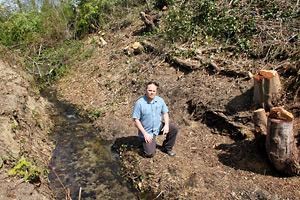VIDEO – A population of cutthroat trout that had been thriving in a small stream may not survive after neighbourhood residents destroyed all growth surrounding it.
The stream flows along a steep bank just below Laburnum Avenue, through what is known as the old golf course, vacant land in Townsite now owned by PRSC Limited Partnership. Trout, which are highly vulnerable to urban development and agricultural practices that remove streamside vegetation, are natural to the creek.
In March, Grady Sindlinger, who lives on Laburnum, noticed someone was clearing treetops in the bush across the street from his home. When he investigated, he discovered that quite a lot of ivy and brambles had been cleared, along with some old timber and some freshly cut younger trees. As the activity continued, Sindlinger realized the clearing was escalating and he saw some neighbours working with a wheelbarrow and an ATV, hauling wood that had been cut to woodstove size out of the area.
Alarmed, he contacted the City of Powell River and was referred to the ministry of forests, lands and natural resource operations. An enforcement officer informed him the residents had a letter that gave them permission to clear bush there. Sindlinger felt better, he said, but his alarm increased as the activity continued. When he went down to the creek again, he discovered an absolute clear-cut right up to and across the small creek.
“It’s just not an ecological practice, to clear right up to a creek bed and over it, let alone removing larger trees from the edge,” Sindlinger said. “The average person has been exposed enough now for the last 20 to 40 years to what ecology is and what it means and how to care for the planet that it doesn’t make sense for someone to think this is okay.”
Scott Randolph is the manager of Powell River Regional Economic Development Society, which has a contract to manage PRSC lands. He said a group of residents who live on Laburnum and Larch Avenue approached him asking for permission to improve their sight lines. “I was fine with sight lines, but they were not to cut any further and they were especially not to cut anywhere near the riparian area there,” he said.
He required the group to give him a letter, Randolph said, which removed the company from any liability. It also stated the residents understood there was a creek there and that they were not to cut anywhere near it, Randolph added. “I guess two of the residents took it upon themselves to, in their words, do us a favour by clearing up the bank,” he said. “As soon as I found out, I stopped them and I told them, ‘You are not to cut another piece of wood down there and you are to leave it alone, you have contravened the agreement that was made.’”
Randolph said he was doing the group a favour by allow them to top some trees so their views weren’t ruined. “They went overboard,” he said. “They went past what was agreed to.”
Ryan Barfoot, sustainability and ecological educator for School District 47, has been exploring the possibility of students becoming stewards of the stream ever since he spotted trout in it. “The alders in that area are very important to the health of that little ecosystem,” he said. “Alders are a successional species which fix nitrogen in the soil while providing shelter for the young firs and cedars as they grow.”
The alders also act to stabilize the bank for the houses above as well as preventing siltation of the creek, he said. “Ironically, now that the alders have been cut, the invasive blackberries and English Ivy will flourish and the fish may be in jeopardy.”
Coastal cutthroat is a blue-listed species, which means it is considered vulnerable in BC. Several populations on the east coast of Vancouver Island and Lower Mainland are in serious decline.
The city’s subdivision procedures bylaw and infrastructure design and construction bylaw require that a riparian area assessment be prepared by a qualified environmental professional to assess the impacts of development within 30 metres of a fish-bearing watercourse.



